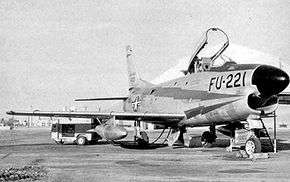93d Fighter-Interceptor Squadron
| 93d Fighter-Interceptor Squadron | |
|---|---|
|
Squadron F-86D Sabre[note 1] | |
| Active | 1942–1945; 1946–1960 |
| Country |
|
| Branch |
|
| Role | Fighter-Interceptor |
| Engagements |
Mediterranean Theater of Operations China-Burma-India Theater |
| Insignia | |
| 93d Fighter-Interceptor Squadron emblem (approved 6 August 1958)[1] |
 |


- Note: For the current USAF unit, see 93d Fighter Squadron
The 93d Fighter-Interceptor Squadron is an inactive United States Air Force unit. Its last assignment was with the Albuquerque Air Defense Sector, stationed at Kirtland Air Force Base, New Mexico. It was inactivated on 8 July 1960.
History
World War II
The squadron was activated in early 1942[1] under III Fighter Command in North Carolina. It trained initially with Bell P-39 Airacobras, it was then re-equipped with Lockheed P-38 Lightnings.[1]
Moved overseas between October 1942 and February 1943,[1] the ground echelon established itself in French Morocco with the force that invaded North Africa on 8 November. The air echelon, which had trained for a time in England, arrived in North Africa between late December 1942 and early February 1943.
The unit began combat with the Twelfth Air Force in January 1943, supporting ground operations during the Allied drive against Axis forces in Tunisia. It patrolled the coast of North Africa and protected Allied shipping in the Mediterranean Sea between April and July 1943. It also provided cover for the convoys that landed troops on Pantelleria island on 11 June and on Sicily on 10 July 1943. The squadron supported the landings at Anzio on 22 January 1944 and flew patrols in that area for a short time.
Transferred to the China-Burma-India Theater, it moved to India in February and March 1944.[1] It initially carried out training with Curtiss P-40 Warhawk and Republic P-47 Thunderbolt aircraft. Moving to China in May, it became part of the Fourteenth Air Force. The squadron continued training and on occasion flew patrols and escort missions before returning to full-time combat duty in January 1945. It attacked enemy airfields and installations, flew escort missions and aided the operations of Chinese ground forces by attacking troop concentrations, ammunition dumps, lines of communication and other targets to hinder Japanese efforts to move men and matèriel to the front.
It was inactivated in China on 27 December 1945.[1]
Cold War
The squadron was reactivated at Wheeler Field, Hawaii in late 1946. It was equipped with North American P-51 Mustangs and was responsible for the air defense of the Hawaiian Islands until 1949. It was reassigned to Continental Air Command, Ninth Air Force, being stationed in New Mexico. Re-equipped with Lockheed F-80 Shooting Star jet aircraft, it trained as a tactical fighter squadron. The unit upgraded to North American F-86A Sabre day interceptors in 1951, performing air defense duties over the Sandia National Laboratories in New Mexico at Kirtland Air Force Base.
It was re-equipped with F-86Ds in 1953. It began upgrading to the F-86L in 1957, which incorporated the Semi Automatic Ground Environment, or SAGE computer-controlled direction system for intercepts. The duration of the F-86L's service was destined to be quite brief, since by the time the last 'L' was delivered, the type was already being phased out in favor of supersonic interceptors. The squadron was inactivated in 1960[1] during an ADC reorganization and phase-out of the F-86 from active-duty units.
Lineage
- Constituted as the 93d Pursuit Squadron (Interceptor) on 13 January 1942
- Activated on 9 February 1942
- Redesignated the 93d Fighter Squadron on 15 May 1942
- Inactivated on 8 December 1945
- Activated on 15 October 1946
- Redesignated 93d Fighter-Interceptor Squadron on 20 January 1950
- Discontinued on 8 July 1960[1]
Assignments
- 81st Pursuit Group (later 81st Fighter Group), 9 February 1942 – 8 December 1945
- 81st Fighter Group (later 81st Fighter-Interceptor Group), 15 October 1946 (attached to Albuquerque Air Defense Area after 1 May 1950)
- Western Air Defense Force, 10 August 1951 (attached to 34th Air Division)
- 34th Air Division, 6 February 1952
- Albuquerque Air Defense Sector, 1 January – 8 July 1960[1]
Stations
|
|
Aircraft
|
References
- Notes
- ↑ Aircraft is North American F-86D-35-NA Sabre serial 51-6221, taken about 1955. Aircraft markings were red lightning bolts on the fuselage.
- Citations
Bibliography
![]() This article incorporates public domain material from the Air Force Historical Research Agency website http://www.afhra.af.mil/.
This article incorporates public domain material from the Air Force Historical Research Agency website http://www.afhra.af.mil/.
- Cornett, Lloyd H; Johnson, Mildred W (1980). A Handbook of Aerospace Defense Organization, 1946 - 1980 (PDF). Peterson AFB, CO: Office of History, Aerospace Defense Center. Retrieved March 23, 2012.* Maurer, Maurer, ed. (1983) [1961]. Air Force Combat Units of World War II (PDF) (reprint ed.). Washington, DC: Office of Air Force History. ISBN 0-912799-02-1. LCCN 61060979.
- Maurer, Maurer, ed. (1982) [1969]. Combat Squadrons of the Air Force, World War II (PDF) (reprint ed.). Washington, DC: Office of Air Force History. ISBN 0-405-12194-6. LCCN 70605402. OCLC 72556.
- "ADCOM's Fighter Interceptor Squadrons". The Interceptor. Aerospace Defense Command. Vol. 21 (No. 1): 5–11, 26–31, 40–45, 54–59. January 1979.


.jpg)